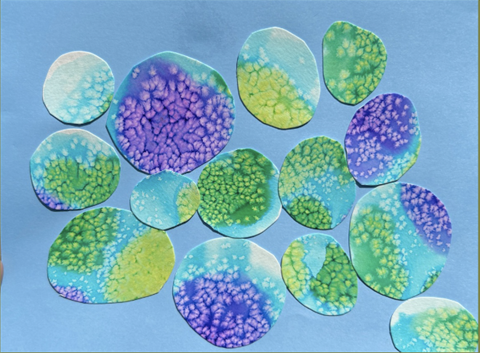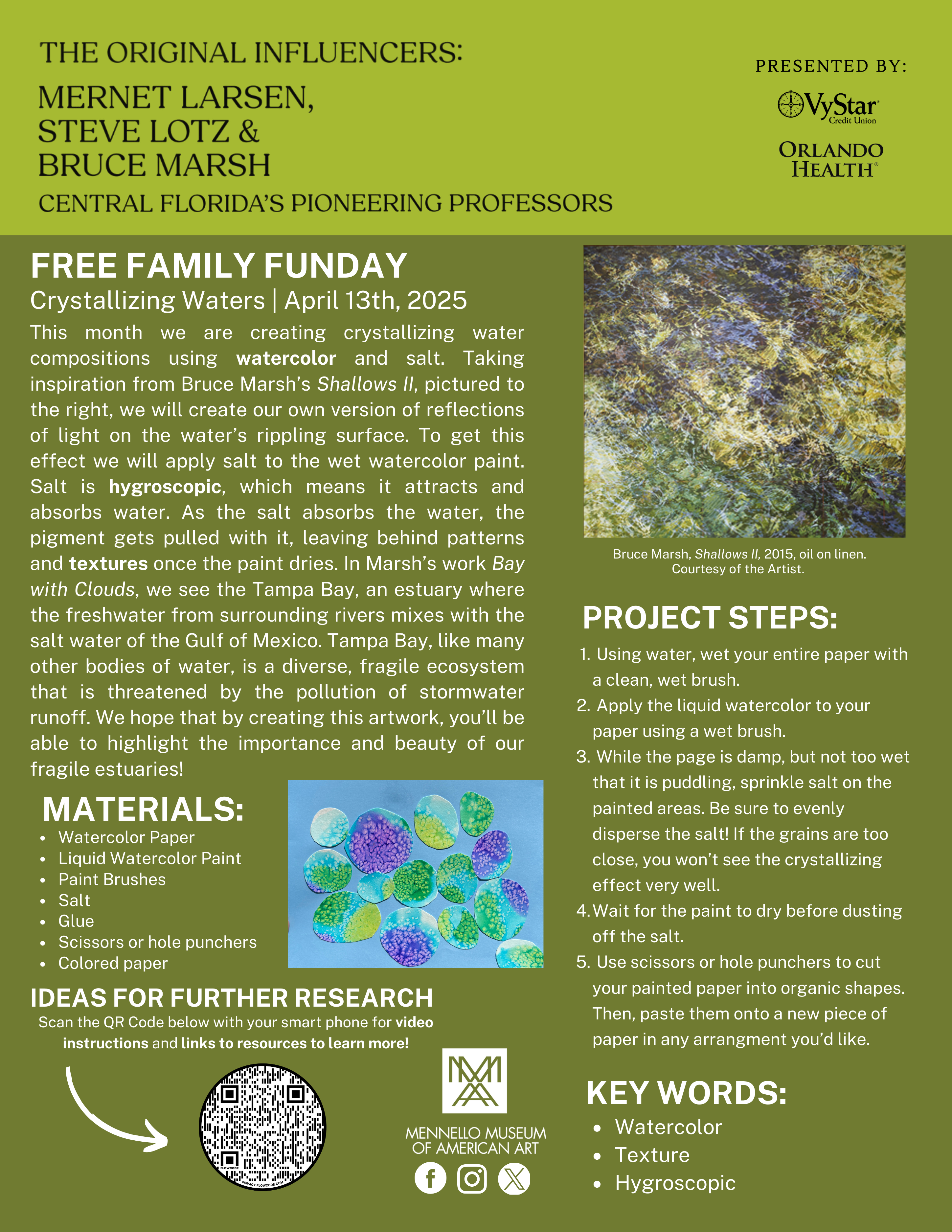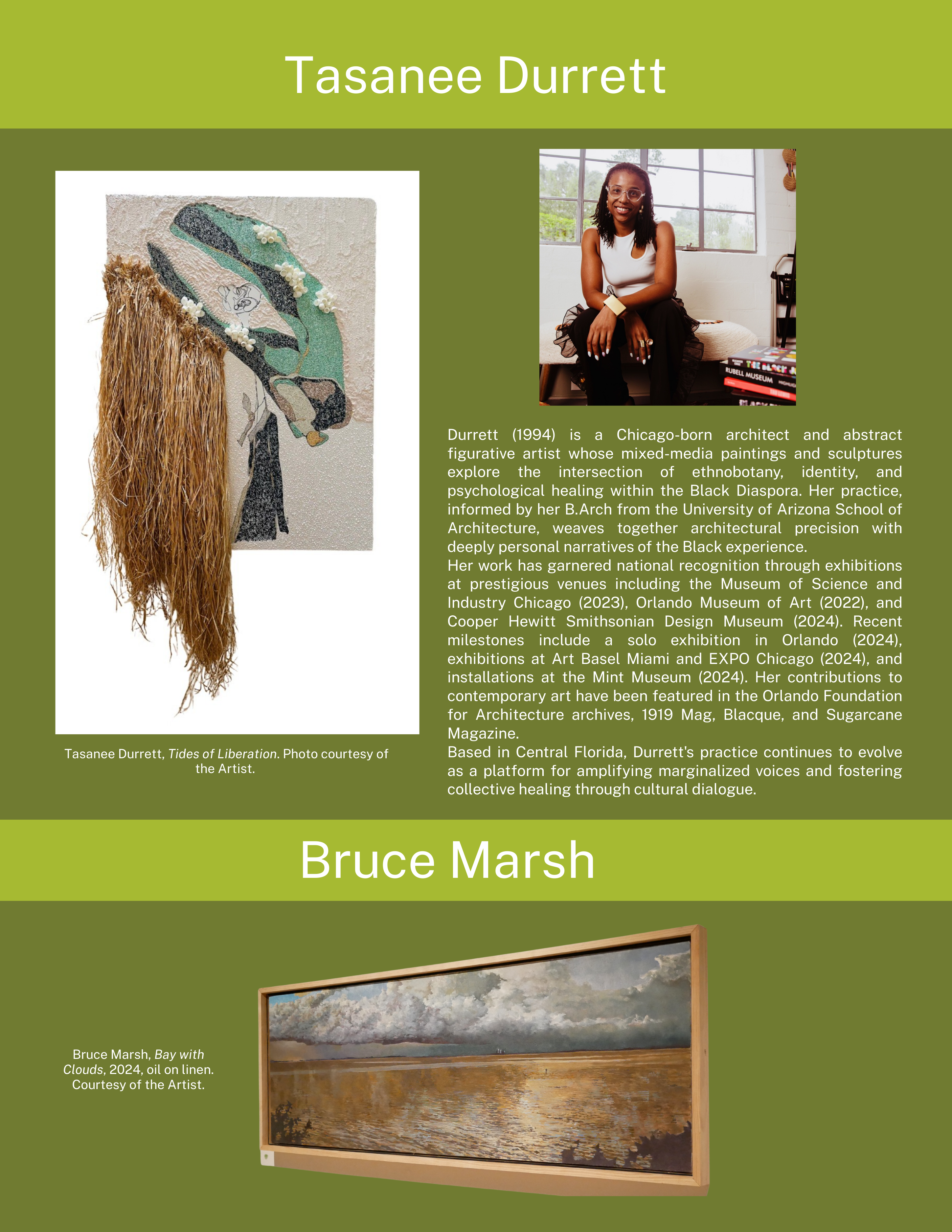Crystallizing Waters | Free Family Funday | April 2025

Ver más abajo para obtener instrucciones en español.
Crystallizing Waters | April 13th, 2025
This month we are creating crystallizing water compositions using watercolor and salt. Taking inspiration from Bruce Marsh’s Shallows II, pictured to the right, we will create our own version of reflections of light on the water’s rippling surface. To get this effect we will apply salt to the wet watercolor paint. Salt is hygroscopic, which means it attracts and absorbs water. As the salt absorbs the water, the pigment gets pulled with it, leaving behind patterns and textures once the paint dries. In Marsh’s work Bay with Clouds, we see the Tampa Bay, an estuary where the freshwater from surrounding rivers mixes with the salt water of the Gulf of Mexico. Tampa Bay, like many other bodies of water, is a diverse, fragile ecosystem that is threatened by the pollution of stormwater runoff. We hope that by creating this artwork, you’ll be able to highlight the importance and beauty of our fragile estuaries!
Materials Needed:
Watercolor Paper
Liquid Watercolor Paint
Paint Brushes
Salt
Glue
Scissors or hole punchers
Colored paper
Project Steps:
1. Using water, wet your entire paper with a clean, wet brush.
2. Apply the liquid watercolor to your paper using a wet brush.
3. While the page is damp, but not too wet that it is puddling, sprinkle salt on the painted areas. Be sure to evenly disperse the salt! If the grains are too close, you won’t see the crystallizing effect very well.
4. Wait for the paint to dry before dusting off the salt.
5. Use scissors or hole punchers to cut your painted paper into organic shapes. Then, paste them onto a new piece of paper in any arrangement you’d like.


Aguas Cristalizantes | April 13th, 2025
Este mes crearemos composiciones de agua cristalizada con acuarela y sal. Inspirándonos en Shallows II de Bruce Marsh, que se muestra a la derecha, crearemos nuestra propia versión de reflejos de luz en la superficie ondulante del agua. Para lograr este efecto, aplicaremos sal a la acuarela húmeda. La sal es higroscópica, lo que significa que atrae y absorbe el agua. A medida que la sal absorbe el agua, el pigmento se ve arrastrado por ella, dejando patrones y texturas una vez seca la pintura. En la obra de Marsh, "Bahía con Nubes", vemos la Bahía de Tampa, un estuario donde el agua dulce de los ríos circundantes se mezcla con el agua salada del Golfo de México. La Bahía de Tampa, como muchos otros cuerpos de agua, es un ecosistema diverso y frágil, amenazado por la contaminación de las aguas pluviales. Esperamos que, al crear esta obra, puedan destacar la importancia y la belleza de nuestros frágiles estuarios.
MATERIALES:
Papel de acuarela
Acuarela líquida
Pinceles
Sal
Pegamento
Tijeras o perforadoras
Papel de color
PASOS DEL PROYECTO:
1. Con agua, humedece todo el papel con un pincel limpio y húmedo.
2. Aplica la acuarela líquida al papel con un pincel húmedo.
3. Con la página húmeda, pero sin que se forme un charco, espolvorea sal sobre las zonas pintadas. ¡Asegúrate de distribuir la sal uniformemente! Si los granos están demasiado juntos, no se verá muy bien el efecto de cristalización.
4. Espera a que la pintura se seque antes de quitar la sal.
5. Usa tijeras o perforadoras para cortar el papel pintado en formas orgánicas. Luego, pégalas en una hoja nueva con la disposición que prefieras.
When
-
Sunday, April 13, 2025 | 12:00 PM
- 04:30 PM